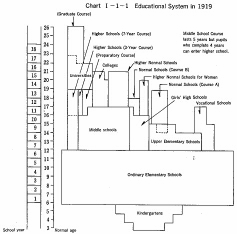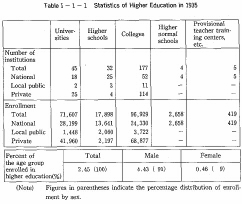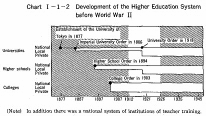| Home > Policy > White Paper, Notice, Announcement > White Paper > JAPAMESE GOVERNMENT POLICIES IN EDUCATION,SCIENCE AND CULTURE 1990 > PART |
||
Before World War ![]() there were various types of institutions
of higher education. including universities, higher schools, colleges, higher
normal schools and others. Institutions of each type played their own role in
accordance with their distinctive objectives and characteristics.
there were various types of institutions
of higher education. including universities, higher schools, colleges, higher
normal schools and others. Institutions of each type played their own role in
accordance with their distinctive objectives and characteristics.
Since the Meiji Restoration, the new Government of Japan endeavored to create and develop various new structures with the aim of creating a modern nation adapted to the current of the times in the world. The Government actively imported and introduced modern thought, science and technology from advanced Western countries. It created, expanded. and improved a modern system of higher education as an integral part of Japan's modernization, Universities. in particular, were defined as "highest institutions of education and learning", and also defined as core institutions responsible for the development of leaders relevant to the new age, as well as for the urgent assimilation of the scientific and cultural products of advanced Western countries.
The system of higher education before World War ![]() was of a
multiple-track type. There were three tracks: one track comprising universities
and pre-university institutions called "higher schools," a second comprising
colleges, and the other composed of higher normal schools and other teacher-training
institutions.(In 1943 normal schools became college-level institutions. See Chart
I-l-1.)
was of a
multiple-track type. There were three tracks: one track comprising universities
and pre-university institutions called "higher schools," a second comprising
colleges, and the other composed of higher normal schools and other teacher-training
institutions.(In 1943 normal schools became college-level institutions. See Chart
I-l-1.)

During the years from the second half of the 188O's to the very beginning of the present century, the Government gradually established the national system of these institutions of higher education, creating and developing national universities and other institutions of higher education. During the l910's and the earlier 1920's the Government helped develop local public and private universities and higher schools, and strove to expand institutions of higher education including colleges.
Table ![]() -l-1 presents the number of institutions of higher education
and enrollment therein, as well as the proportion of the age group enrolled in
these institutions, as of 1935. The Table Indicates that in 1935 there were 45
universities,32 higher schools, 177 colleges and 4 higher normal schools. The
proportion of the age group enrolled in these institutions was 2.5%, a very small
percentage as compared with the proportion of the age group enrolled in higher
education at the present time when higher education has been greatly popularized.
-l-1 presents the number of institutions of higher education
and enrollment therein, as well as the proportion of the age group enrolled in
these institutions, as of 1935. The Table Indicates that in 1935 there were 45
universities,32 higher schools, 177 colleges and 4 higher normal schools. The
proportion of the age group enrolled in these institutions was 2.5%, a very small
percentage as compared with the proportion of the age group enrolled in higher
education at the present time when higher education has been greatly popularized.

The pre-war system of universities and higher schools is outlined as follows:

| Back to Top | MEXT HOME |